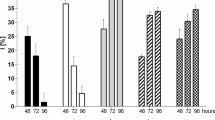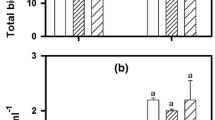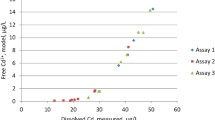Abstract
Impact of Cu, Ni and Fe on structure and function of a synthetic microcosm, comprising of four algae (Chlorella vulgaris, Chlamydomonas sp., Anabaena doliolum and Oscillatoria formosa), two arthropods (Cyclops and Cypris) and a protozoan (Paramecium) was tested with respect to nutrient depletion, changes in algal population, chlorophyll a content and carbon fixation. The control (untreated) microcosm registered complete depletion of NO3 - and PO4 3- on day 20, when the algal population had reached its maxima in terms of cell number, chlorophyll a content and carbon fixation. Metal treated microcosm, however, showed a delayed nutrient depletion, reduced algal maxima, and lower chlorophyll a content and carbon fixation rate than the control. Of the four algae tested Chlamydomonas sp. was found to the most sensitive and Oscillatoria formosa, the most tolerant to all the metals used. The hierarchy of metal toxicity was Cu>Ni>Fe. Cu and Ni combination interacted synergistically in contrast to the antagonism of Cu+Fe and Ni+Fe. Carbon fixation was inhibited most as compared to nutrient depletion, algal number and chlorophyll a content. A comparison of the microcosm results with batch cultures using the same metals and algae revealed a similar pattern, but a reduced degree of inhibition in the former. This study therefore, demonstrates that results of laboratory toxicity bioassays can be extrapolated to the field level though with a reduced precision.
Similar content being viewed by others
References
Allen, M.B. and Arnon, D.I. (1955) Studies on nitrogen fixing blue-green algae. I. Growth and nitrogen fixation by Anabaena cylindrica Lemm. Pl. Physiol. 30, 366–72.
American Public Health Association (APHA), (1985) Standard Methods for the Examination of Water and Wastewater. 16th edition. Washington, D.C.
Arnold, D.E. (1972) Ingestion, assimilation, survival and reproduction by Daphnia pulex fed on seven species of blue-green algae. Limnol. and Oceanog. 16, 906–20.
Awong, J. Bitton, G. and Chaudhry, G.R. (1990) Microcosm for assessing survival of genetically engineered microorganisms in aquatic environments. Applied Environ. Microbiol. 56, 977–83
Cairns, J.Jr. (1980) Beyond single species toxicity testing. UK: Pergamon Press.
Gerloff, G.C., Fitzgerald, G.P. and Skoog, F. (1950) The isolation, purification and culture of blue-green algae. Am. J. Bot. 37, 216–8.
Giesey, J.Jr. and Odum, E. (1980) Microcosmology: Introductory comments. In Giesey, J.Jr ed. Microcosm in Ecological Research, pp. 1–13. Springfield, VA: National Information Service
Greipsson, S. and Crowder, A.A. (1992) Amelioration of copper and nickel toxicity by iron plaque on roots of rice (Oryza sativa). Can. J. Bot. 70: 824–30.
Gross, R.E., Punso, P. and Dugger, W.M. (1970) Observations on the mechanism of copper damage in Chlorella. Plant Physiol. 46, 183–5.
Hamdy, M.K. and Wheeler, S.R. (1978) Inhibition of bacterial growth by mercury and the effects of protective agent. Bull. Environ. Contam. Toxicol. 230: 378–86.
Hughes, E.O., Gorham, P.R. and Zehnder, A. (1958). Toxicity of a unialgal culture of Microcystis aeruginosa. Can. J. Microbiol. 4, 225.
Mackinney, G. (1941) Absorption of light by chlorophyll solution. J. Biol. Chem. 140, 315–22.
Mallick, N. and Rai, L.C. (1989) Response of Anabaena doliolum to bimetallic combinations of Cu, Ni and Fe with special reference to sequential addition. J. Appl. Phycol. 1, 301–6.
Mallick, N. and Rai, L.C. (1990) Effect of heavy metals on the biology of a N2-fixing cyanobacterium Anabaena doliolum. Toxicity Assessment 5, 207–20.
Mallick, N. and Rai, L.C. (1992) Metal induced inhibition of photosynthesis, photosynthetic electron transport chain and ATP content of Anabaena doliolum and Chlorella vulgaris. Biomed. Environ. Sci. 5, 241–50.
Mallick, N, Singh, A.K. and Rai, L.C. (1990) Impact of bimetallic combinations of Cu, Ni and Fe on growth rate, uptake of nitrate and ammonium, 14CO2 fixation, nitrate reductase and urease activity of Chlorella vulgaris. Biol. Metals 2, 229–34.
Munawar, M., Munawar, I.F., Mayfield, C.I. and McCarthy, L.H. (1989) Probing ecosystem health: a multi-disciplinary and multitrophic assay strategy. Hydrobiologia 188/189, 93–116.
National Research Council, (1981) Testing for effects of chemicals on ecosystems. Washington, D.C.; National Academy Press.
Nicholas, D.J. and Nason, A. (1957) Determination of nitrate and nitrite. In Colowick, S.P. and N.O.Kaplan eds. Methods in Enzymology, III. pp. 981–4. New York USA: Academic Press.
Rai, L.C. and Raizada, M. (1986) Nickel-induced stimulation of growth, heterocyst differentiation, 14CO2 uptake and nitrogenase activity in Nostoc muscorum. New Phytol. 104, 111–4.
Rai, L.C., Singh, A.K. and Mallick, N. (1990) Employment of CEPEX enclosures for monitoring toxicity of Hg and Zn on in situ structural and functional characteristics of algal communities of river Ganga in Varanasi, India. Ecotoxicol. Environ. Safety 20, 211–21.
Stokes, P.M. (1975) Adaptation of green algae to high level of copper and nickel in aquatic environments. In Hutchinson, T.C. ed. Proceedings of International Conference on Heavy Metals in the Environment, pp. 137–54. Toronto, Canada:
Sunda, W.G., Tester, P.A. and Huntsman, S.A. (1990) Toxicity of trace metals on Acartia tonsa in the Elizabeth river, southern Chesapeake Bay Atlantic Ocean. Estuarine Coastal Shelf Science 30, 207–22.
Swollow, K.C., Hume, D.N. and Morel, F.M.M. (1980) Sorption of copper and lead by hydrous ferric oxide. Environ. Sci. Technol. 14, 1326–31.
Taub, F.B., (1984) Synthetic microcosms as biological models of algal communities. In Shubert, L.E. ed.. Algae as Ecological Indicators, pp. 363–94. New York, USA: Academic Press.
Taub, F.B. and Kindig, A.C. (1986) Standardized aquatic microcosm protocol.. Final report. Rockville, Maryland: Department of Health and Human Services. Food and Drug Administration.
Wong, P.T.S., Chau, Y.K. and Patel, D. (1983) The use of algal batch and continuous culture techniques in metal toxicity study. In Nariagu, J.O. ed. Aquatic Toxicology, pp. 450–66. USA: John Wiley and Sons, Inc.
Author information
Authors and Affiliations
Rights and permissions
About this article
Cite this article
Rai, L.C., Mallick, N. Heavy metal toxicity to algae under synthetic microcosm. Ecotoxicology 2, 231–242 (1993). https://doi.org/10.1007/BF00368532
Received:
Accepted:
Issue Date:
DOI: https://doi.org/10.1007/BF00368532




